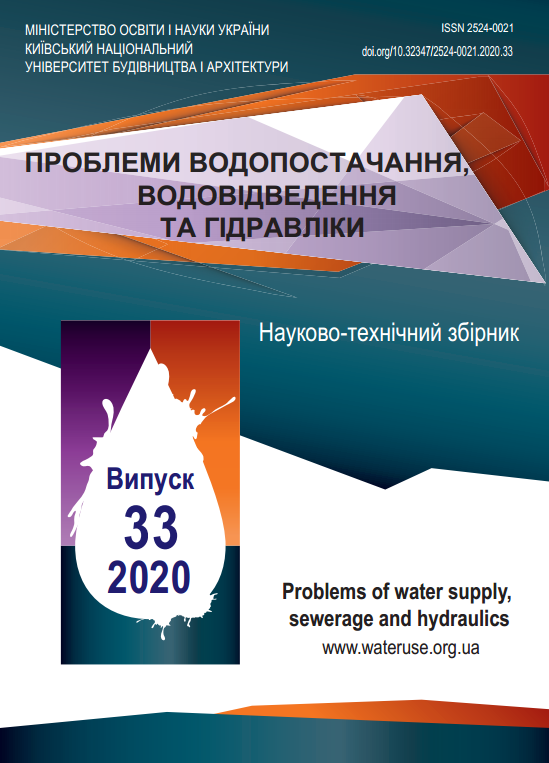Pipelines designing for steady water collection along the path
DOI:
https://doi.org/10.32347/2524-0021.2020.33.34-40Ключові слова:
perforation, collecting perforated pipeline, steady discharge along the pathАнотація
The technique of engineering calculation of perforation holes area which is variable along the length of the channel and provides steady fluid inflow along the path is developed in the article. It is based on previously obtained analytical solutions of differential equations describing the fluid motion in pressure perforated pipelines of a constant cross section. The use of such pipes in treatment plants will increase their efficiency. It is determined that the steady fluid inflow along the length of the pipe can be secured only by its non-steady walls perforation. The maximum perforation of the pipeline walls should be ensured at the initial sections of the channel, and the minimum – at their last sections. The corresponding graphs are built according to the formulas. Convenient empirical dependencies for determining the hydraulic friction coefficient and the coefficient of perforation holes discharge for the considered case are proposed. The results of the calculations according to the proposed method are confirmed by the results of experimental studies.Посилання
Bolshakov, V. A., & Kravchuk, A. M. (2000). Determination of perforated pipelines parameters that provide a technologically defined mode of fluid collection. Bulletin of TAU and NTU, 2, 138-143. [in Ukrainian].
Ehorov, A. I. (1984). Hydraulics of pressure tubular systems in water treatment plants. Moscow: Stroyizdat. [in Russian].
Vasilenko, A. A., & Kravchuk, A. M. (1991). Hydraulic calculation of collecting pipelines in water supply and water sewerage structures. Hydraulics and hydraulic engineering, 52, 57-61. [in Russain].
Smirnov, V. P. (Ed.) (1979). Recommendations for the hydraulic calculation of pressure tubular systems for water collecting in water treatment plants. Moscow: VNIIVODGEO. [in Russian].
Fedorets, A. A. (1976). Differential equations of steadystate fluid motion in pipelines with nonsteady flow rate variation. Izv. Vuzov. Construction and architecture, 10, 114-119. [in Russain].
Petrov, H. A. (1964). Variable weight hydraulics. Kharkiv: Edition of Kharkiv University. [in Russian].
Konstantinov, Yu. M., & Kravchuk, A. M. (1993). Special issues of hydraulics of water supply and water sewerage systems: Tutorial. Kyiv, Ukraine, 136. [in Ukrainian].
Kravchuk, A. M. (1988). Determination of attaching mass coefficient in perforated pipelines. Hydraulics and hydraulic engineering, 46, 7-9. [in Russain].
Navoyan, H. A. (1973). Hydraulic calculation of pressure pipes with uniformly varying flow along the path. Scientific research in hydraulic engineering in 1973, 3, 31-38. [in Russian].
Kamke, E. (1961). Handbook of ordinary differential equations. Moscow: Fizmatgiz. [in Russian].
Vasilenko, A. A., & Kravchuk, A. M. (1986). Hydraulic calculation of perforated collecting pipelines of arbitrary length. Hydraulics and hydraulic engineering, 43, 70-73. [in Russain].
Claudio, D. (1962). I condotti emungenti da in serbatoio. Contronto fra risultati teorici esperimentali atti e men. Accad. patav. scilettere ed arti 1961–1962, 74(2), 188-197.
Dwight, G. B. (1977). Tables of integrals and other mathematical data. Moscow: Nauka. [in Russian].
Kravchuk, A. M., & Kravchuk, O. Y. (2016). Analysis of kinematic characteristics of collecting perforated pipelines. Problems of water supply, sewerage and hydraulics, 26, 152-160. [in Ukrainian].
Altshul, A. D. (1970). Hydraulic resistance. Moscow: Nedra. [in Russian].
Bolshakov, V. A., Konstantinov, Y. M., & Popov, V. N. (1984). Hydraulic handbook. Kyiv: Vysha shkola. [in Russian].
##submission.downloads##
Опубліковано
Як цитувати
Номер
Розділ
Ліцензія
Автори, які публікуються у цьому журналі, погоджуються з наступними умовами:
a) Автори залишають за собою право на авторство своєї роботи та передають журналу право першої публікації цієї роботи, яка через 70 років після смерті останнього співавтора з дати публікації автоматично стає доступною на умовах ліцензії Creative Commons Attribution License, котра дозволяє іншим особам вільно розповсюджувати опубліковану роботу з обов'язковим посиланням на авторів оригінальної роботи та першу публікацію роботи у цьому журналі.
b) Автори мають право укладати самостійні додаткові угоди щодо неексклюзивного розповсюдження роботи у тому вигляді, в якому вона була опублікована цим журналом (наприклад, розміщувати роботу в електронному сховищі установи або публікувати у складі монографії), за умови збереження посилання на першу публікацію роботи у цьому журналі.
c) Політика журналу дозволяє і заохочує розміщення авторами в мережі Інтернет (наприклад, у сховищах установ або на особистих веб-сайтах) рукопису роботи, як до подання цього рукопису до редакції, так і під час його редакційного опрацювання, оскільки це сприяє виникненню продуктивної наукової дискусії та позитивно позначається на оперативності та динаміці цитування опублікованої роботи (див. The Effect of Open Access).


